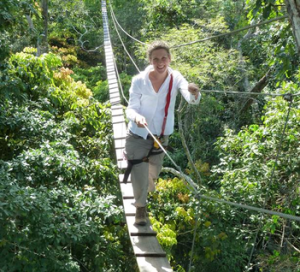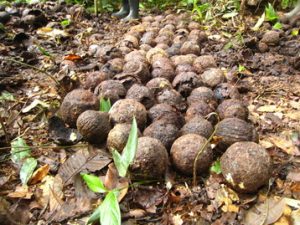
From the February 2021 Desktop News | In the Amazon rainforest, the Brazil nut tree is an invaluable resource. Towering over their harvesters’ homes at over 160 feet tall, the tree produces fruit that contains the famous Brazil nut, which economically sustains the thousands of people who live there. But the Brazil nut tree’s yield varies from year to year–sometimes it’s bountiful and sustains the harvesters financially, but sometimes, the trees don’t provide a single fruit.
UA biology professor Christina Staudhammer, along with researchers from the University of Florida and institutions in Brazil, is working to help these villages find solutions to maintain a steady supply of the Brazil nut. In an article recently published in Nature Scientific Reports, Staudhammer’s team recounts 10 years of data to determine what factors most greatly impact the tree’s fruit production and how harvesters who rely on the tree can maximize the tree’s output, as well as several other groups in the Amazon and around the world.
“This tree is intimately connected to the culture of the Brazilian Amazon and to the people that live there,” Staudhammer said. “It’s not just the harvesters relying on the Brazil nut product for income. There is a huge multi-million dollar industry built up around processing the seeds for export. Moreover, these trees are hyperdominant in terms of their contribution to carbon storage and sequestration in the Amazon. Plus, they provide food for an important game species, the agouti.”
Over the course of these 10 years, Staudhammer compared two sites of trees that were 20 miles apart, checking to see if climatic conditions, landscape changes, or human disturbances caused a difference in production. The team discovered that two factors had the most impact on the trees: soil nutrition and El Niño conditions.
“In general, the soils in the Amazon are very poor,” Staudhammer said. “They’re young soils that are very low in nutrients. But one of the sites had higher levels of potassium and phosphorus, and that site, regardless of the climatic conditions, had a lot more consistent fruit production.

“The other thing that we found was that there was a connection to some of the climatic patterns, in particular El Niño conditions. If the dry season before flowering was particularly dry, then they would have production that was quite a bit lower. This complicates things because, at that point, the trees are forming fruit for the next season, and these dry conditions can slow that process. So the weather that’s happening a year and a half before the fruits fall is really what’s controlling the production that we get.”
Because of these findings, Staudhammer and her team searched for solutions to help the harvesters have a more consistent output of Brazil nuts instead of turning to quick-fix solutions, such as clearing trees for cow pastures, which damages the ecosystem and the climate of that area.
Unlike some trees, the Brazil nut tree does not fare well in plantations—the bees that the trees rely on for pollination do not seek out the tree because it’s not their primary source of food. Instead, they pollinate the trees that they stumble upon, the ones that they find on their journey to their primary food source. Because of this, less trees produce fruit, meaning there are less Brazil nuts for the harvesters to sell.
Because these trees cannot be traditionally “farmed” in order to be fertilized, Staudhammer offers alternative methods of increasing Brazil nut production. Instead of planting new trees that take over half a century to grow, the team urged the harvesters to focus on taking care of the trees already there.
“Our take-home for the harvesters is that, if they have a few low years, there are things that we think that they can do to protect themselves from low production,” Staudhammer said. “For instance, keep the surrounding forest intact. Pollinators rely on diverse, mature forests. Also, very low amounts of phosphorus or potassium fertilizer, might help them to stabilize their crops. There’s not a lot of these trees, but the trees will produce hundreds of fruits, each with 20 or so nuts inside. So there are things that they can do to make sure those trees produce what they need.”
To read the full article, click here.